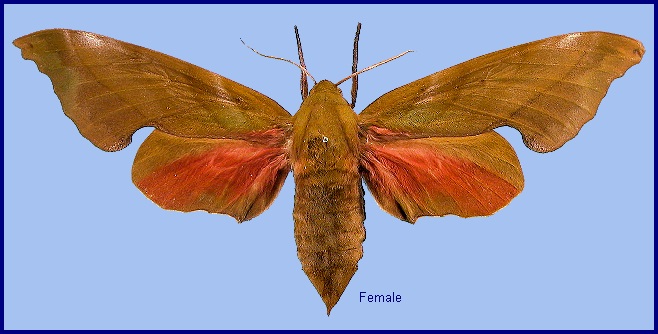
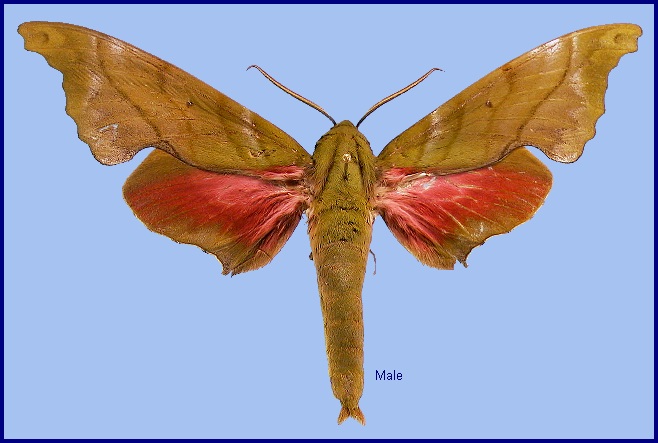
Rhodoprasina callantha Jordan, 1929, Novit. zool. 35: 86. Type locality: [India,] Assam [Meghalaya], Shillong.
Synonym. Callambulyx yunnanensis Dong, 2018, J. Biochem. Mol. Biol. Res. 3(1): 204.
Note. Based mainly on the extent of white/silver and carmine red pigmentation, Rhodoprasina callantha has been split up by Brechlin (2015b) into three separate subspecies, namely Rhodoprasina callantha callantha (northern India, Nepal, Bhutan and northern Myanmar/Burma), Rhodoprasina callantha callsinica (China (Yunnan), northern Thailand and northern Vietnam), and Rhodoprasina callantha centrovietnama (central Vietnam and northern Laos).
Wingspan: 90--120mm. Sexually dimorphic; female often considerably larger than male. An umistakable species with sharply pointed, usually olive-green (male) or tawny-olive (female) forewings crossed by diagonal dark lines and diffuse white/silver bands. Hindwing carmine red above with costal and anal margins olive-green. Extent of white/silver and carmine pigmentation variable. Body olive-green, darker below. Antennae pink. Tibiae and tarsi blackish and grey.
There is also a rarer pale brown form, where all green pigmentation is replaced by shades of yellowish-brown. Pinned/papered normal green forms will also change to pale brown if exposed to excessive moisture or ethyl acetate.
Whereas in the similar Rhodoprasina floralis (Butler, 1877) the foretibia bears a long thorn or claw at the apex, there is no such armature in Rhodoprasina callantha (Jordan, 1929).
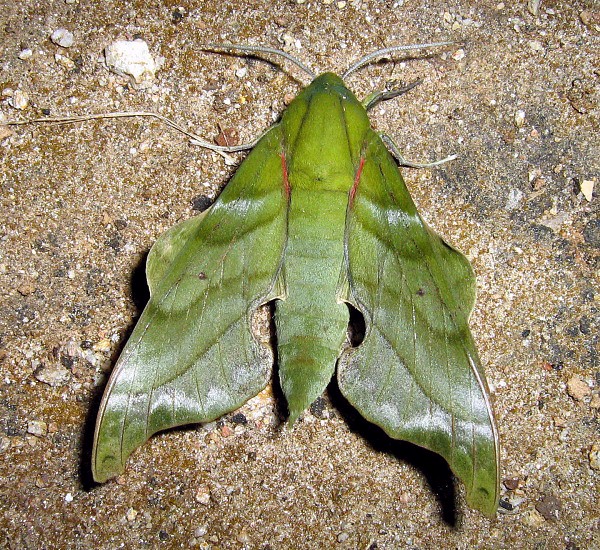
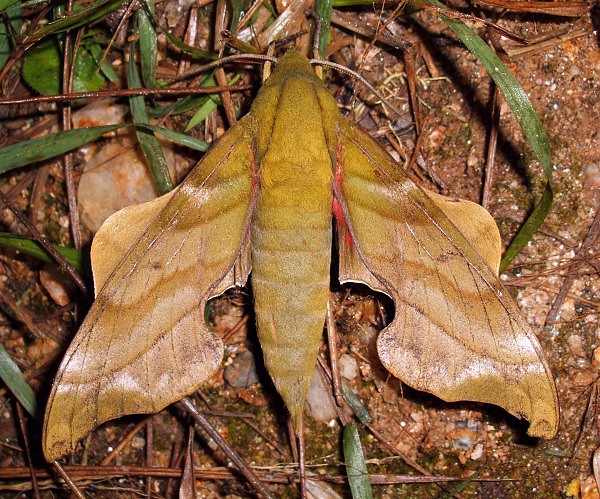
In Thailand, occurs at between 1200 and 2100m altitude in dense oak forests which become very wet during the rainy season.
In India, a female exposed for three or four nights failed to attract a male. She was very active at night and battered her wings to pieces (Bell & Scott, 1937).
China: 27.ii (Yunnan); 15.iii-10.iv (Yunnan); 10.iv (Sichuan); 23.iv-13.vi (Yunnan).
In Thailand, January-April, June and August-November (Inoue, Kennett & Kitching, [1996] 1997; Thomas Ihle, pers. comm. 2010).
OVUM: Pale green, elongate-oval, surface smooth and shiny. These are laid singly on the underside of a leaf of the hostplant (Bell & Scott, 1937).
LARVA: Full-fed 90mm, width 18mm, horn 6mm, head 14mm long by 8mm broad. According to Bell & Scott (1937), in the first instar head round, body cylindrical, horn long, straight; colour pale green; head 1.5mm long by 1.1mm broad. In the second instar, head triangular, with a long tuberculate process rising from apex of each lobe, the two processes closely appressed. Body cylindrical. Horn of medium length, straight, ending in a conical point. Colour of head and body green, with a subdorsal line of multi-pointed orange tubercles from front margin of segment 2 to base of horn. There are seven oblique lateral stripes formed of orange tubercles. The spiracle of segment 5 surrounded by an ocellus-like marking, dark green edged with crimson. Head 5mm long by 1.8mm broad. There is little change in the third instar, except for an encircling row of small orange tubercles around each secondary ring; head 9mm high by 3.5mm broad.
In the fourth instar, head very elongate-triangular in shape, with a blunt-ended process rising from apex of each lobe, the two processes so closely appressed that they appear to be an upward prolongation of the head. The anterior secondary ring of segment 2 of greater diameter than base of head, the secondary rings decreasing in diameter to the middle of the segment; from the middle of 2 the body increasing in diameter gradually to 10, then decreasing gradually. Surface of head moderately shiny, set sparsely with small tubercles. Horn straight, of medium length, tapering evenly to a blunt point, held slightly above the horizontal; anal flap and claspers heavy. Body dull; a transverse row of small tubercles around each secondary ring. There is a larger tubercle close to the dorsal line on each secondary ring, forming a subdorsal line of tubercles from front margin of segment 2 to base of horn, these tubercles increasing in size posteriorly. There are seven oblique lateral stripes formed of larger tubercles, that on 5 formed of larger tubercles than the rest; scattered tubercles on horn, anal flap and claspers (Bell & Scott, 1937).
Head pale bluish-green, the tubercles white; a narrow green stripe runs from the apex of each process to base of antenna, and from apex of each process to nape, where it joins the dorsal stripe of the body. Body segments 2 to 4 pale bluish-green, rest of body green. A broad dark green dorsal stripe runs from front margin of 2 to base of horn. An indistinct whitish stripe is present on each side of the dorsal stripe, the tubercles on this pale stripe orange. There is also an indistinct whitish dorso-lateral stripe on 2 to 4. The oblique lateral stripe on 5 pale yellow, the remaining oblique stripes whitish and less broad, the tubercles on the stripes orange. Horn pale yellow with orange tubercles; the transverse and those on anal flap and claspers orange. Spiracles white edged with black; that on segment 5 broader than the rest, and surrounded by an ocellus-like marking, dark own ringed with crimson. Head 9 mm. long by 3.5 mm. broad (Bell & Scott, 1937).
In the fifth and final instar, head very large and heavy, elongate-triangular in shape, vertex rounded and dorsal line shallowly impressed; the processes represented by a flat tubercle on apex of each lobe true clypeus about one-fifth length of head, apex acute, basal angles rounded and tumid; false clypeus a very narrow strip outside true clypeus; labrum one-third length of clypeus and slightly broader than clypeus, with a ridge on each side of the dorsal line, the lateral ends tumid; ligula as long as broad, the deep triangular sinus having a narrowly rounded lobe on each side. Surface of head slightly shiny, set sparsely and irregularly with minute tubercles (Bell & Scott, 1937).
Body short and stout; the vertex of the head rises high above segment 2 and the segments increase in diameter gradually to 8, then decrease gradually to 12. Horn short, stout, straight, tapering gradually to a blunt point, and held horizontal or directed slightly downwards, touching or nearly touching dorsum of anal flap; anal flap and claspers tumid and heavy. Surface of body dull, with an encircling row of small pointed tubercles around each secondary ring. There is a line of larger sharply-pointed tubercles on each side of the dorsal line from front margin of segment 2 to base of horn, these tubercles gradually increasing in length to near base of horn. There is also a line of pointed tubercles along each oblique lateral stripe, the tubercles on the oblique stripes of 5 and 11 larger than the rest; those on the oblique stripe of 10 the smallest. The line of tubercles on each segment runs forward on to the adjoining segment, and backwards to near the dorsum of the segment behind, that on 11 running across 12 to base of horn. Large rounded tubercles decorate the horn, anal flap and claspers. These, plus all the tubercles mentioned, setiferous, the subdorsal and dorso-lateral main hairs are not distinguishable, but there are long and extremely fine supra- and subspiracular hairs, and on some hairs on true legs, on shanks of prolegs and on edge of clasper-face (Bell & Scott, 1937).
Face of head bluish-green, cheek pale green; a whitish stripe, edged on the inner side with green, from apex of each lobe to base of antenna, separating face from cheek; a green dorsal stripe from vertex to nape; tubercles white; labrum pale green; ligula brown with a pale green stripe down each lobe; basal and middle segments of antenna greenish, end-segment greenish with brown tip; mandible pale green, tip dark brown. Body varying from pale apple-green to pale bluish-green, segments 2 to 4 paler than the rest and the anal segments darker. There is a whitish subdorsal stripe on 2 to 4, a broad, dark green dorsal stripe from the front margin of 2 to base of horn, and an indistinct whitish stripe on each side of the dorsal stripe, on which the subdorsal line of large tubercles is situated. Seven oblique lateral stripes are present, these being pale yellow, that on 5 broader than the rest, all edged above with dark green and bearing the oblique lines of tubercles. Horn green; anal flap and claspers edged with yellow; all the tubercles orange except those on edge of claspers, where they are yellow. True legs green; prolegs pale blue, the hooklets on the feet red-brown; venter pale bluish-green. Spiracles white edged with black, the white forming a narrow ellipse containing the central slit; the white portion of the spiracle on segment 5 broader than that of the others, and this spiracle surrounded by an ocellus-like marking, dark green edged with crimson (Bell & Scott, 1937).
The larva lies on the underside of a leaf when small and on twigs and branches when large. In the resting position the front part of the body is raised slightly from the surface, the elongated head pointing upwards. The larva is very active. Though none of those found were attacked by parasites they were very difficult to rear, dying for no apparent reason, especially in the earlier instars. They do not become suffused with brown or pink before pupation, which takes place in a cell underground (Bell & Scott, 1937).
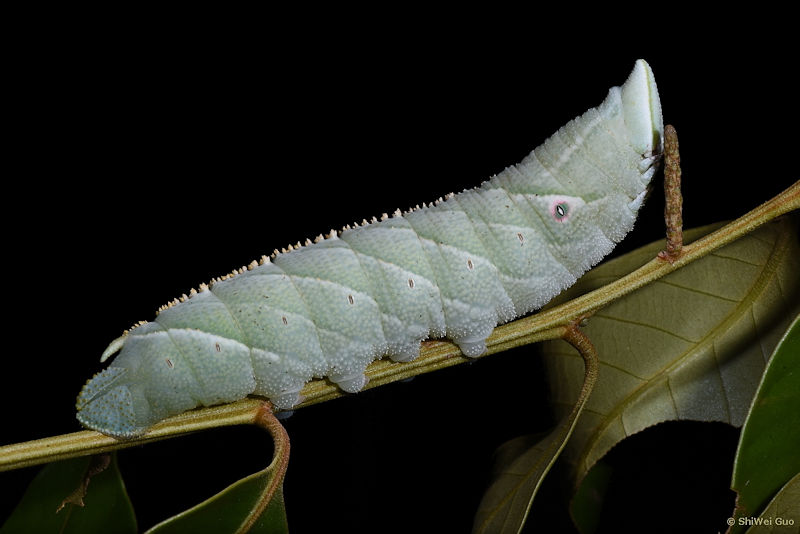
PUPA: 44-60mm, width 15 mm. Colour dark chestnut, the head, thorax, anterior part of wing-cases and cremaster darker, spiracles black with the central slit orange.
Head rounded, rather small, frons nearly vertical; segment 2 of about the same diameter as head, the segments then increasing rapidly to the middle of the body, which is stout. Tongue broad at base, reaching to about middle of wing-case, shorter than fore leg, the tip sometimes covered by the fore leg. Antenna as long as tongue, mid-leg a little longer than fore leg; there is no coxal piece. Surface shiny; head irregularly corrugate; segment 2 rugose, dorsally carinate, antenna distinctly cross-rayed; wing-cases transversely, irregularly corrugate; thorax transversely corrugate on dorsum, obliquely corrugate in lateral area. Abdomen pitted, especially near the front margin of each segment; sculpturing on segment 4 consisting of a highly polished transverse weal on each side of the dorsal line, with a smaller weal behind it; ante-spiracular ridges on 9 to 11 in the form of three parallel ridges of equal length. Spiracle of 2 indicated by a slit, bordered in front by the hind margin of 2 and behind by a weal along the front margin of 3; remaining spiracles oval with a very narrow rim, the surface rising from the rim to a smaller depressed oval containing the central slit. Cremaster conical, very coarsely corrugate; a broad, corrugate keel along the venter; the tip smooth, very shortly bent downwards, conical and bluntly pointed; horn and sears may be present or absent.
The pupae are also delicate, and the moths which emerged are often crippled (Bell & Scott, 1937).
Larval hostplants. Wild hosts were not recorded for China, but reared in captivity on Lithocarpus dealbatus (Hook. f. & Thomson ex Miq.) (Xu ZhenBang, pers. comm. 2024). In India, on species of Quercus, especially Quercus fenestrata (Bell & Scott, 1937).
Unknown.
China: Sichuan (Panzhihua); Yunnan (nr. Yingjiang, Xima, 2080m; Luxi; Pingba; Simao/Pu'er, 1360m; Puwen, 30km SSW Simao/Pu'er, 900m; 10km W Yunxian; Daxing, 120km S Dali, 1200m; 5km N Hutiao Xia (river), 2200m; 120km N Dali; Gaoligong Shan; Malipo County, Wenshan Zhuang, 1860m; Xishan, Kunming; Menghai County; Daweishan National Park; Daduguangxiang, Xishuangbanna; Tuanjie Central School Campus).
From northeastern India and Nepal across Bhutan, northern Myanmar/Burma, southwestern China (Sichuan and Yunnan), northern Thailand, northern Laos to northern Vietnam.
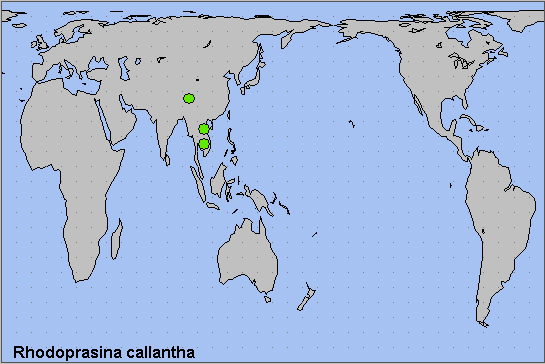
Holarctic; eastern Palaearctic region. Pleistocene refuge: Monocentric -- Yunnan refugium.
 Return to Sphingidae of the Eastern Palaearctic species list
Return to Sphingidae of the Eastern Palaearctic species list